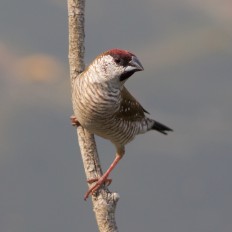Located on the western side of the Greater Blue Mountains area of New South Wales, the Capertee Valley is a world-renowned birding location, regularly featuring in 'top-ten' lists of Australian birdwatching destinations. In 2010 the former sheep grazing property 'Port Macquarie', situated on the Capertee River in the central part of the valley, was acquired by NSW National Parks & Wildlife Service and formally reserved and reserved as Capertee National Park to protect one of the last remaining core breeding areas of the critically endangered Regent Honeyeater (Anthochaera phrygia). The park hosts a rich community of temperate woodland birds with over 170 species recorded, including a number of threatened and uncommon species that can be relatively easy to find here. For example, Regent Honeyeater, Turquoise Parrot, Diamond Firetail, Hooded Robin, Gang-gang Cockatoo, Speckled Warbler, Painted Honeyeater and Black-chinned Honeyeater. White-backed Swallows at their eastern range limit can be seen over the open paddocks and Spotted Quail-thrush, Chestnut-rumped Heathwren and Rockwarbler inhabit the scrubby hillslopes. The habitat in the park consists mainly of grassy box-gum and box-ironbark woodlands, riparian Casuarina forests and shrubby ironbark-grey gum-Callitris woodlands on the slopes and ridges.
Located on the western side of the Greater Blue Mountains area of New South Wales, the Capertee Valley is a world-renowned birding location, regularly featuring in 'top-ten' lists of Australian birdwatching destinations. In 2010 the former sheep grazing property 'Port Macquarie', situated on the Capertee River in the central part of the valley, was acquired by NSW National Parks & Wildlife Service and formally reserved as Capertee National Park to protect one of the last remaining core breeding areas of the critically endangered Regent Honeyeater (Anthochaera phrygia). The park hosts a rich community of temperate woodland birds with over 170 species recorded, including a number of threatened and uncommon species that can be relatively easy to find here. For example, Regent Honeyeater, Turquoise Parrot, Diamond Firetail, Hooded Robin, Gang-gang Cockatoo, Speckled Warbler, Painted Honeyeater and Black-chinned Honeyeater. White-backed Swallows at their eastern range limit can be seen over the open paddocks and Spotted Quail-thrush Quail-thrush, Chestnut-rumped Heathwren and Chestnut-rumped Heathwren inhabit Rockwarbler inhabit the dryer scrubby hillslopes. The habitat in the park consists mainly of grassy box-gum and box-ironbark woodlands, riparian Casuarina forests and shrubby ironbark-grey gum-Callitris woodlands on the slopes and ridges.
Located on the western side of the Greater Blue Mountains area of New South Wales, the Capertee Valley is a world-renowned birding location, regularly featuring in 'top-ten' lists of Australian birdwatching destinations. In 2010 the former sheep grazing property 'Port Macquarie', situated on the Capertee River in the central part of the valley, was acquired by NSW National Parks & Wildlife Service and formally reserved as Capertee National Park to protect one of the last remaining core breeding areas of the critically endangered Regent Honeyeater (Anthochaera phrygia). The park hosts a rich community of temperate woodland birds with over 170 species recorded, including a number of threatened and uncommon species that can be relatively easy to find here. For example, Regent Honeyeater, Turquoise Parrot, Diamond Firetail, Hooded Robin, Gang-gang Cockatoo, Speckled Warbler, Painted Honeyeater and Black-chinned Honeyeater. White-backed Swallows at their eastern range limit can be seen over the open paddocks and Spotted Quail-thrush and Chestnut-rumped Heathwren inhabit the dryer scrubby hillslopes in small numbers.hillslopes. The habitat in the park consists mainly of grassy box-gum and box-ironbark woodlands, riparian Casuarina forests and shrubby ironbark-grey gum-Callitris woodlands on the slopes and ridges.
Located on the western side of the Greater Blue Mountains area of New South Wales, the Capertee Valley is a world-renowned birding location, regularly featuring in 'top-ten' lists of Australian birdwatching destinations. In 2010 the former sheep grazing property 'Port Macquarie', situated on the Capertee River in the central part of the valley, was acquired by NSW National Parks & Wildlife Service and formally reserved as Capertee National Park to protect one of the last remaining core breeding areas of the critically endangered Regent Honeyeater (Anthochaera phrygia). The park hosts a rich community of temperate woodland birds with over 170 species recorded, including a number of threatened and uncommon species that can be relatively easy to find here. For example, Regent Honeyeater, Turquoise Parrot, Diamond Firetail, Hooded Robin, Gang-gang Cockatoo, Speckled Warbler, Painted Honeyeater and Black-chinned Honeyeater. The White-backed Swallows at their eastern range limit can be seen over the open paddocks and Spotted Quail-thrush and Chestnut-rumped Heathwren inhabit the dryer scrubby hillslopes in small numbers. The habitat in the park consists mainly of grassy box-gum and box-ironbark woodlands, riparian Casuarina forests and shrubby ironbark-grey gum-Callitris woodlands on the slopes and ridges.
Located on the western side of the Greater Blue Mountains area of New South Wales, the Capertee Valley is a world-renowned birding location, regularly featuring in 'top-ten' lists of Australian birdwatching destinations. In 2010 the former sheep grazing property 'Port Macquarie', situated on the Capertee River in the central part of the valley, was acquired by NSW National Parks & Wildlife Service and formally reserved as Capertee National Park to protect one of the last remaining core breeding areas of the critically endangered Regent Honeyeater (Anthochaera phrygia). The park hosts a rich community of temperate woodland birds with over 170 species recorded, including a number of threatened and uncommon species that can be relatively easy to find here. For example, Regent Honeyeater, Turquoise Parrot, Diamond Firetail, Hooded Robin, Gang-gang Cockatoo, Speckled Warbler, Painted Honeyeater and Black-chinned Honeyeater. The habitat consists mainly of grassy box-gum and box-ironbark woodlands, riparian Casuarina forests and shrubby ironbark-grey gum-Callitris woodlands on the slopes and ridges.
Located on the western side of the Greater Blue Mountains area of New South Wales, the Capertee Valley is a world-renowned birding location, regularly featuring in 'top-ten' lists of Australian birdwatching destinations. In 2010 the former sheep grazing property 'Port Macquarie', situated on the Capertee River in the central part of the valley, was acquired by NSW National Parks & Wildlife Service and formally reserved as Capertee National Park to protect one of the last remaining core breeding areas of the critically endangered Regent Honeyeater (Anthochaera phrygia). The park hosts a rich community of temperate woodland birds with over 170 species recorded, including a number of threatened and uncommon species that can be relatively easy to find here. For example, Regent Honeyeater, Turquoise Parrot, Diamond Firetail, Hooded Robin, Gang-gang Cockatoo, Speckled Warbler, Painted Honeyeater and Black-chinned Honeyeater. The habitat consists mainly of grassy box-gum and box-ironbark woodlands, riparian Casuarina forests and shrubby ironbark-grey gum-Callitris woodlands on the slopes and ridges.



